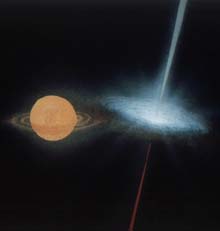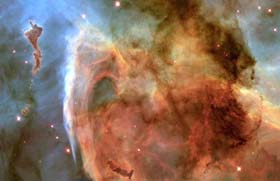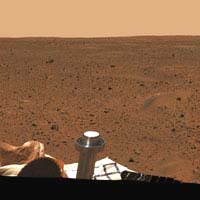This area deals with the fundamental laws and building blocks of nature and how they interact, the properties and the behavior of matter, and research into space and time and their structures.
innovations-report provides in-depth reports and articles on subjects such as astrophysics, laser technologies, nuclear, quantum, particle and solid-state physics, nanotechnologies, planetary research and findings (Mars, Venus) and developments related to the Hubble Telescope.

ESA’s Mars Express, successfully inserted into orbit around Mars on 25 December 2003, is about to reach its final operating orbit above the poles of the Red Planet. The scientific investigation has just started and the first results already look very promising.
Although the seven scientific instruments on board Mars Express are still undergoing a thorough calibration phase, they have already started collecting amazing results. The first high-resolution images and spectra of Mars have al

Scientists using CSIRO’s Australia Telescope Compact Array, a radio synthesis telescope in New South Wales, Australia, have seen a neutron star spitting out a jet of matter at very close to the speed of light. This is the first time such a fast jet has been seen from anything other than a black hole.
The discovery, reported in this week’s issue of ’Nature’, challenges the idea that only black holes can create the conditions needed to accelerate jets of particles to extreme speeds.

Frozen helium-4 behaves like a combination of solid and superfluid
Researchers at the Pennsylvania State University are announcing the possible discovery of an entirely new phase of matter: an ultra-cold, “supersolid” form of helium-4.
Writing in the 15 January 2004 issue of the journal Nature, Penn State physicist Moses H. W. Chan and his graduate student, Eun-Seong Kim, explain that their material is a solid in the sense that all its helium-4 atoms are frozen into a rigid

Previously unseen details of a mysterious, complex structure within the Carina Nebula (NGC 3372), also called the ’Keyhole Nebula’, are revealed by this image obtained with the NASA/ESA Hubble Space Telescope.
The picture is a montage assembled from four different April 1999 telescope pointings with Hubble’s Wide Field Planetary Camera 2, which used six different colour filters.
The picture is dominated by a large, approximately circular feature, about 7 light-years acro

An international team of scientists working in the UK, Australia, Italy and the USA has made an astronomical discovery that has major implications for testing Einstein’s general theory of relativity.
Using the 64-m CSIRO Parkes radio telescope in New South Wales, Australia, the team recently detected the first system of two pulsars orbiting each other – the only system of its kind found so far among the 1400-plus pulsars discovered in the last 35 years.
Team member Dr. Richard

The first 360-degree color view from NASA’s Spirit Mars Exploration Rover presents a range of tempting targets from nearby rocks to hills on the horizon.
“The whole panorama is there before us,” said rover science- team member Dr. Michael Malin of Malin Space Science Systems, San Diego. “It’s a great opening to the next stage of our mission.”
Spirit’s flight team at NASA’s Jet Propulsion Laboratory, Pasadena, Calif., continues making progress toward getting the